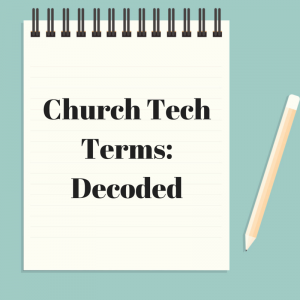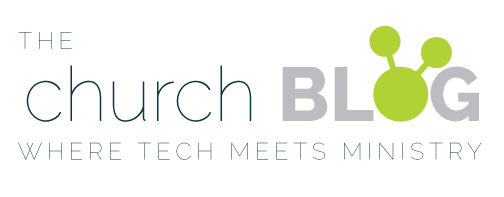 Last week, we looked at some of the most basic terms that you should be familiar with in the church tech world. We know that on The Church Blog, we’ll be using a great deal of these terms, and we want you to feel more comfortable in their meaning.
Last week, we looked at some of the most basic terms that you should be familiar with in the church tech world. We know that on The Church Blog, we’ll be using a great deal of these terms, and we want you to feel more comfortable in their meaning.
Here are a few more tech terms that we can clarify for you:
Blog
A blog is a great communication piece for your church and is a fantastic way to stay in touch with your church between services. Most content on a church’s website is static or unchanging, but a blog is dynamic content that can update regularly.
Domains/URLs
For all practical purposes, these terms are the same thing. In the physical world, we have street addresses. In the digital world, we have domain names or uniform resource identifiers (URLs). Thechurchblog.com is an example. Every website that exists on the world wide web actually has a numerical address called an IP address which tells your browser where to look for the website files. Since these are nearly impossible to remember and look terrible on a business card, a domain name can be used. The easy-to-remember domain name points the browser to the specific location of the website files.
Top Level Domain (TLD)
This specifically speaks to the ending of a website’s URL. TLDs used to be very limited to just a few choices (.com, .net, .org, and .gov), but have recently experienced a major expansion. You can even grab .church domains. If your church has had trouble snagging an appropriate .com or .org because of it’s common name, this might be your chance to get a better domain name.
Content Management System (CMS)
CMS is a pretty common term in the tech space, but that doesn’t mean everyone understands what it means. Most simplified, a CMS is a place where you as the user are allowed to login to the backend resources of your website or app and make necessary changes. A simple-to-use CMS is an important feature to look into when signing up for a website, app, or other technology that may require you to make edits.
Secure Sockets Layer (SSL)
This particular term is one you are likely to come across when researching giving software, though it does have applications in various types of web activities. Any time an online interaction happens, there is a potential for a hacker to intercept that information. Because of the confidential nature of things like online purchases and donations, there needs to be an added level of protection for those types of interactions. Sites that employ the SSL protocol encrypt the data in such a way that it cannot be intercepted and read by anyone except the intended target. You will definitely want to make sure that any giving software you choose is using the latest SSL protocol. You may also see this referred to as TSL or Transport Layer Security, but they are essentially the same thing.
Look for more tech terms decoded in the weeks to come!


March 12, 2015
I learned something new today… pls include what RSS means on your next post!
March 13, 2015
Awesome, Abby! So glad to hear that it was helpful. I’ll make sure to include RSS in an upcoming post.